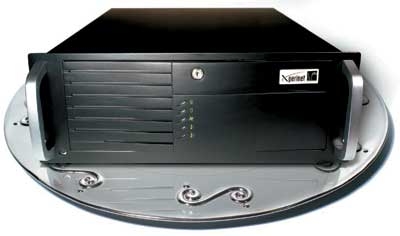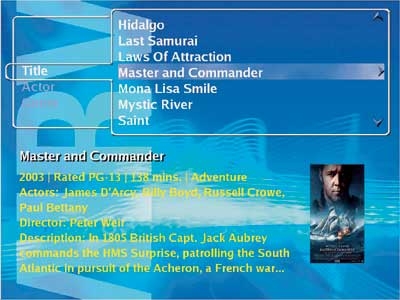The Connected House: Serve It Up! Page 4
Though you've likely never heard of Xperinet, the ability to distribute uncompressed video signals places its servers at the top of the food chain. Using something the company calls Multiple Independent Replay Video (MIRV) technology, Xperinet servers can deliver up to 20 simultaneous streams from up to 1,600 DVDs stored in 8 terabytes of hard-drive space! (A terabyte, by the way, is a thousand gigabytes.) 
The Polaris is Xperinet's entry-level server, capable of storing up to 250 DVDs and supporting concurrent streams for up to six of its Taurus clients. Polaris can also manage your music collection, holding any combination of CDs and DVDs up to its memory capacity. A DVD stored bit for bit in MPEG-2 format is roughly equivalent to 11 uncompressed CDs. Other video formats that can be stored include MPEG-1, MPEG-4, DiVX, Windows Media Video, QuickTime, and Sony DV, while CDs can be ripped in FLAC, Ogg Vorbis, or MP3 format.
|
The back of the Polaris and Taurus clearly show their roots, being more akin to computers than typical A/V gear. The absence of a composite-video output shouldn't be an issue, but the lack of a component-video output is noteworthy. Xperinet says it will address this in a running line change, but in the interim, several companies make VGA-to-component-video cables. I used the DVI connection, which can be scaled to a variety of resolutions. Audio connects directly to your A/V system, with a variety of options. The Ethernet port connects to your network. The supplied keyboard includes an IR receiver that connects to the mouse/keyboard inputs and works with any learning remote control.
Once the Polaris is connected, you can set up preferences for each zone. For instance, I selected DTS and widescreen for my home theater and two-channel stereo and standard 4:3 for my bedroom. Some network configuration is necessary to get everything up and running.
Due to the, er-hmm, sensitive legal environment surrounding the issue of copying DVDs, the Polaris doesn't include the software you'll need to rip copyrighted discs. However, new owners are sent instructions via e-mail on how to search for third-party software on the Web. Once you know the Web site, you simply type the URL into one of the Polaris's setup screens, and the server automatically goes out and gets the software so you can start loading your movies.
To prevent you from transferring copyrighted material to the Internet, you can't access files stored on Polaris from any other computer. Unfortunately, that also means that you can't drag and drop your existing music or video files onto the server. All files, whether music or movies, must be loaded the old-fashioned way - one disc at a time. (Xperinet says it is working on a utility for grabbing content from computers on your network.) A movie takes around 13 minutes to load. A big plus is that each Taurus client has its own DVD player that can load discs to the hard drive, too. You can also watch a movie stream while another disc is loading.
Polaris recognizes every discrete section of a DVD - from the FBI warning on to the last extra - as a "title," and it doesn't rip the entire disc, just the titles you select. After a DVD is inserted, a screen appears listing all titles on the disc - including bonus features, trailers, and so on. However, the titles are identified only by number, which makes selecting what to record more difficult. All audio and caption tracks are automatically recorded, so commentaries and multiple languages are retained.
Using the Xperinet was a pleasure. Since I ripped only the movies themselves, it jumped straight to the start - I never had to wait through a warning, trailer, or menu screen. Polaris doesn't record chapter markers. Instead, you skip forward or back through the movie (there are three speeds). While this wasn't as convenient as chapter skipping, it wasn't a real hassle, either. You do lose your place when you exit a movie, though, and since there's no time or chapter information, finding where you left off takes some hunting. Xperinet claims that a software update will address both these issues. Regarding updates, each Polaris comes with a three-year service agreement, which includes free firmware upgrades.
Let me say up front - I'm a movie person. I probably watch three a week. Having instant access to all my movies, in every room, in pristine quality was outstanding. I never experienced a stutter or glitch while using either Polaris or Taurus. Also, DVD disc-layer changes, and the momentary stutter they sometimes cause, were nonexistent. I would probably still love this system if it could only play DVDs, but it handles CDs as well. Xperinet, do I have to send it back?
 PDF: How They Stack Up
PDF: How They Stack Up





























































